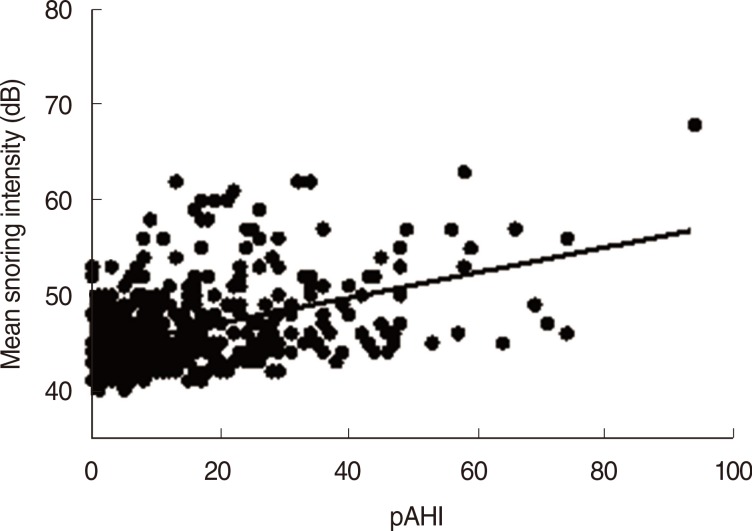Clin Exp Otorhinolaryngol.
2015 Dec;8(4):376-380. 10.3342/ceo.2015.8.4.376.
Relationship Between Snoring Intensity and Severity of Obstructive Sleep Apnea
- Affiliations
-
- 1Department of Otorhinolaryngology, Seoul National University Bundang Hospital, Seoul National University College of Medicine, Seongnam, Korea.
- 2Department of Otorhinolaryngology, Dankook University College of Medicine, Cheonan, Korea. jihunmo@gmail.com
- KMID: 2128913
- DOI: http://doi.org/10.3342/ceo.2015.8.4.376
Abstract
OBJECTIVES
The aim of this study was to determine the relationship between the intensity of snoring and severity of sleep apnea using Watch-PAT (peripheral arterial tone) 100.
METHODS
A total of 404 patients (338 males and 66 females) who underwent home-based portable sleep study using Watch-PAT 100 for obstructive sleep apnea (OSA) from January 2009 through December 2011 were included in this study. Subjects were divided into 4 groups; no OSA (PAT apnea hypopnea index [pAHI]<5/hour), mild OSA (5< or =pAHI<15/hour), moderate OSA (15< or =pAHI<30/hour), or severe OSA groups (pAHI> or =30/hour). Mean snoring intensity and percent sleep time with snoring intensity greater than 40, 50, and 60 dB were measured by Watch-PAT 100. Correlations of these parameters with apnea hypopnea index (AHI), respiratory disturbance index (RDI), and oxygen desaturation index were assessed.
RESULTS
The mean age and body mass index were 46.5+/-14.8 years and 24.7+/-3.4 kg/m2, respectively. Mean AHI and RDI were 16.5+/-15.3/hour and 20.8+/-14.3/hour, respectively. The mean snoring intensity in the no, mild, moderate, and severe OSA groups was 44.0+/-2.7, 45.4+/-6.0, 47.7+/-5.0, and 50.5+/-5.6 dB, respectively (P<0.001). There was a positive correlation between snoring intensity and pAHI or PAT RDI (pRDI) (r=0.391 and r=0.385, respectively, both P<0.001). There was also a positive correlation between percent sleep time with the snoring intensity greater than 50 dB and pAHI or pRDI (r=0.423 and r=0.411, respectively, both P<0.001).
CONCLUSION
This study revealed that the intensity of snoring increased with the severity of sleep apnea, which suggests that the loudness of snoring might be an indicator of the severity of OSA.
Keyword
MeSH Terms
Figure
Cited by 1 articles
-
The Utility of Adenotonsillectomy to Treat Snoring in Children: Acoustic Evaluation Using Smartphones
Sang Hoon Lee, Soon Bok Kwon, Ho Byung Lee, Geun Hyung Park, Mi Jin Mun, Young Joong Kim, Soo Kweon Koo
Korean J Otorhinolaryngol-Head Neck Surg. 2018;61(9):465-471. doi: 10.3342/kjorl-hns.2017.01095.
Reference
-
1. Young T, Palta M, Dempsey J, Skatrud J, Weber S, Badr S. The occurrence of sleep-disordered breathing among middle-aged adults. N Engl J Med. 1993; 4. 328(17):1230–1235. PMID: 8464434.
Article2. Ohayon MM, Guilleminault C, Priest RG, Caulet M. Snoring and breathing pauses during sleep: telephone interview survey of a United Kingdom population sample. BMJ. 1997; 3. 314(7084):860–863. PMID: 9093095.
Article3. Maimon N, Hanly PJ. Does snoring intensity correlate with the severity of obstructive sleep apnea? J Clin Sleep Med. 2010; 10. 6(5):475–478. PMID: 20957849.
Article4. Pang KP, Gourin CG, Terris DJ. A comparison of polysomnography and the WatchPAT in the diagnosis of obstructive sleep apnea. Otolaryngol Head Neck Surg. 2007; 10. 137(4):665–668. PMID: 17903588.
Article5. Choi JH, Kim EJ, Kim YS, Choi J, Kim TH, Kwon SY, et al. Validation study of portable device for the diagnosis of obstructive sleep apnea according to the new AASM scoring criteria: Watch-PAT 100. Acta Otolaryngol. 2010; 7. 130(7):838–843. PMID: 20082567.
Article6. Ayas NT, Pittman S, MacDonald M, White DP. Assessment of a wrist-worn device in the detection of obstructive sleep apnea. Sleep Med. 2003; 9. 4(5):435–442. PMID: 14592285.
Article7. Pasterkamp H, Schafer J, Wodicka GR. Posture-dependent change of tracheal sounds at standardized flows in patients with obstructive sleep apnea. Chest. 1996; 12. 110(6):1493–1498. PMID: 8989067.
Article8. Fiz JA, Abad J, Jane R, Riera M, Mananas MA, Caminal P, et al. Acoustic analysis of snoring sound in patients with simple snoring and obstructive sleep apnoea. Eur Respir J. 1996; 11. 9(11):2365–2370. PMID: 8947087.
Article9. Wilson K, Stoohs RA, Mulrooney TF, Johnson LJ, Guilleminault C, Huang Z. The snoring spectrum: acoustic assessment of snoring sound intensity in 1,139 individuals undergoing polysomnography. Chest. 1999; 3. 115(3):762–770. PMID: 10084490.10. Herzog M, Schieb E, Bremert T, Herzog B, Hosemann W, Kaftan H, et al. Frequency analysis of snoring sounds during simulated and nocturnal snoring. Eur Arch Otorhinolaryngol. 2008; 12. 265(12):1553–1562. PMID: 18488241.
Article11. Fiz JA, Jane R, Sola-Soler J, Abad J, Garcia MA, Morera J. Continuous analysis and monitoring of snores and their relationship to the apnea-hypopnea index. Laryngoscope. 2010; 4. 120(4):854–862. PMID: 20222022.
Article12. Pittman SD, Ayas NT, MacDonald MM, Malhotra A, Fogel RB, White DP. Using a wrist-worn device based on peripheral arterial tonometry to diagnose obstructive sleep apnea: in-laboratory and ambulatory validation. Sleep. 2004; 8. 27(5):923–933. PMID: 15453551.
Article
- Full Text Links
- Actions
-
Cited
- CITED
-
- Close
- Share
- Similar articles
-
- Has Snoring Significance for Predicting Obstructive Sleep Apnea Severity?
- Allergic Rhinitis and Sleep-disordered Breathing
- Pathogenesis of Obstructive Sleep Apnea
- Predictors for Presence and Severity of Obstructive Sleep Apnea in Snoring Patients: Significance of Neck Circumference
- Pathophysiology and Diagnosis of Sleep Apnea


